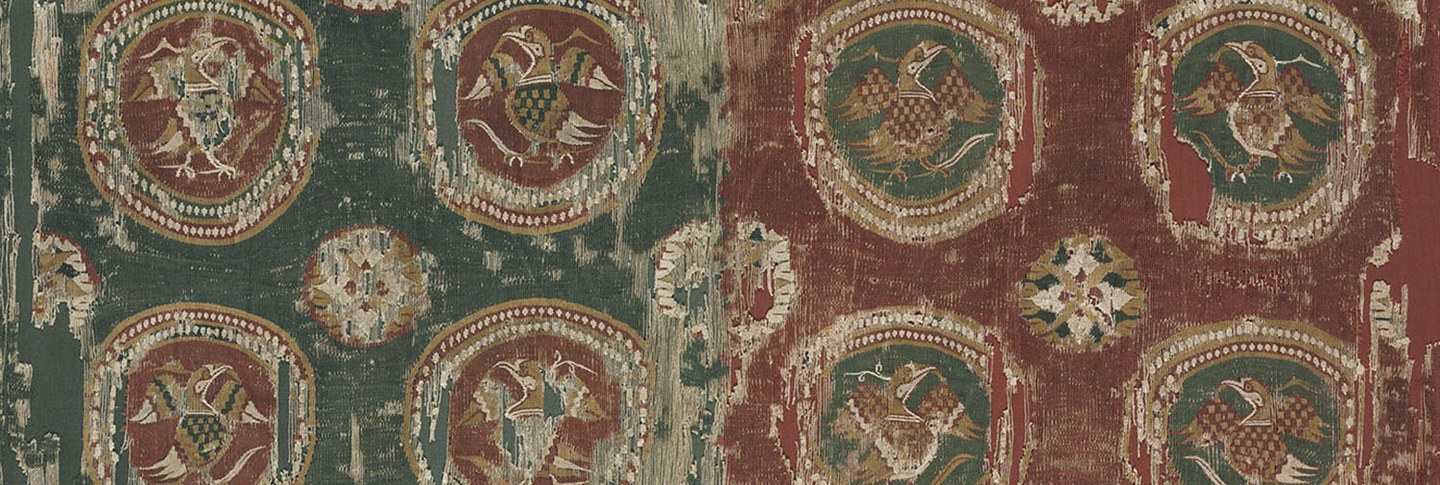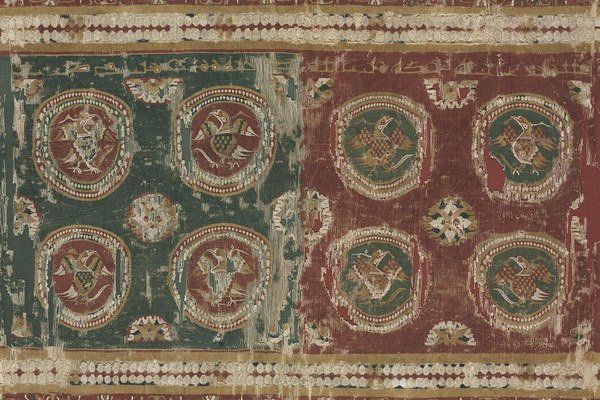Although the Czech explorer and theologian Alois Musil (1868–1944) is today primarily remembered for his scholarly publications, he was also a prolific author of imaginative historical tales based on his travels in the Middle East. His posthumously published Pán Amry (The Lord of Amra), for example, tells a fictional account of medieval life at Quṣayr ʿAmra, an eighth-century palatial site in the desert of modern-day Jordan.A. Musil, Pán Amry (Prague, 1948). Four decades prior, Musil’s study of the site, published in German, had upended art historians’ then-current belief that Islamic art was primarily aniconic by reproducing the elaborate figural paintings that decorated its bathhouse.A. Musil, Ḳuṣejr ʿAmra: Mit einer Karte von Arabia Petraea (Vienna, 1907). Pán Amry, in contrast, was aimed at a general, Czech-speaking audience, and its tone resembles a Hardy Boys–style adventure. It told the swashbuckling tale of Jurata, a young Slav wandering from Byzantium to the Umayyad heartlands, and was vividly illustrated by Václav Fiala, one of the most recognized mid-century graphic artists of Czechoslovakia. Charming illustrations take the reader along on Jurata’s journey, with stops in Constantinople, Palmyra, Ruṣāfa, and Damascus, each showing easily identifiable details drawn from careful study of architecture and architectural decoration. Fiala’s depictions of Quṣayr ʿAmra are true showstoppers; two even appear as reproductions in Garth Fowden’s monograph Quṣayr ʿAmra: Art and the Umayyad Elite in Late Antique Syria.G. Fowden, Quṣayr ʿAmra: Art and the Umayyad Elite in Late Antique Syria (Berkeley, CA, 2004), 55, 117. One especially beautiful plate portrays the hall of the site’s bathhouse with accurately rendered depictions of the wall paintings featured in Musil’s earlier scholarly publication (fig. 1). Fiala places these as the background of a lushly illustrated dance performance. There, a faceless servant pulls open a large, red curtain to reveal a room filled with colorfully dressed spectators, rich furniture, and furnishing textiles of many kinds.
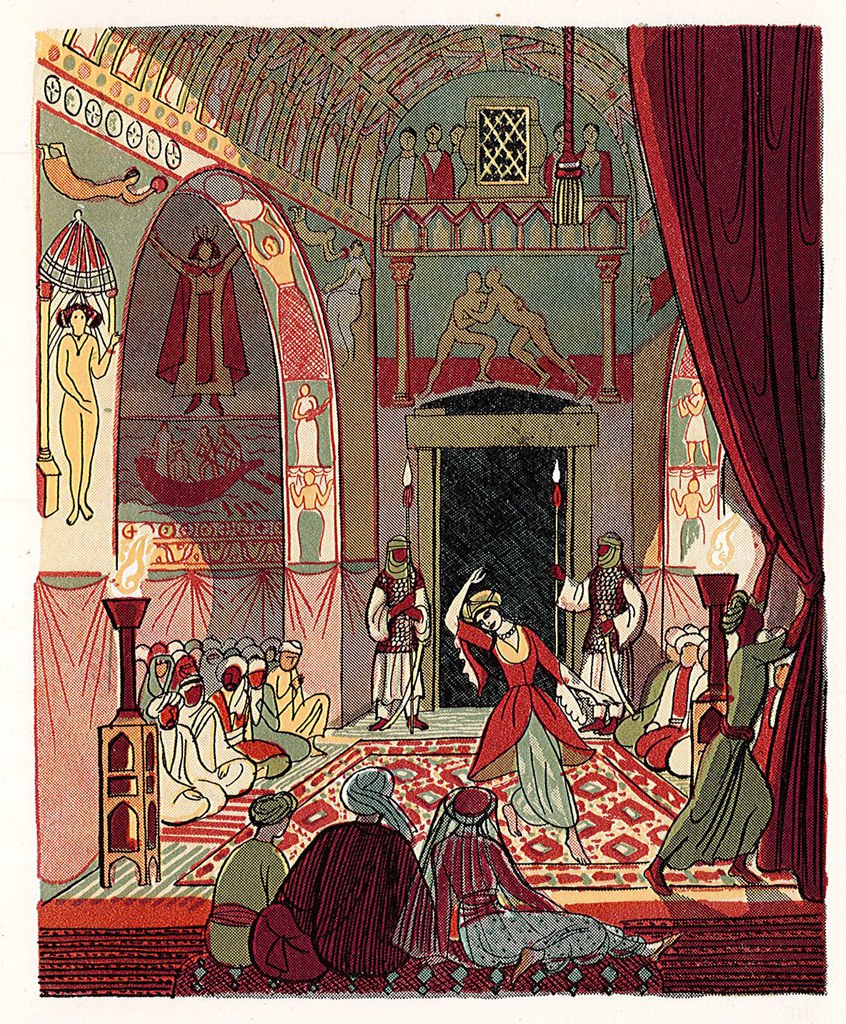
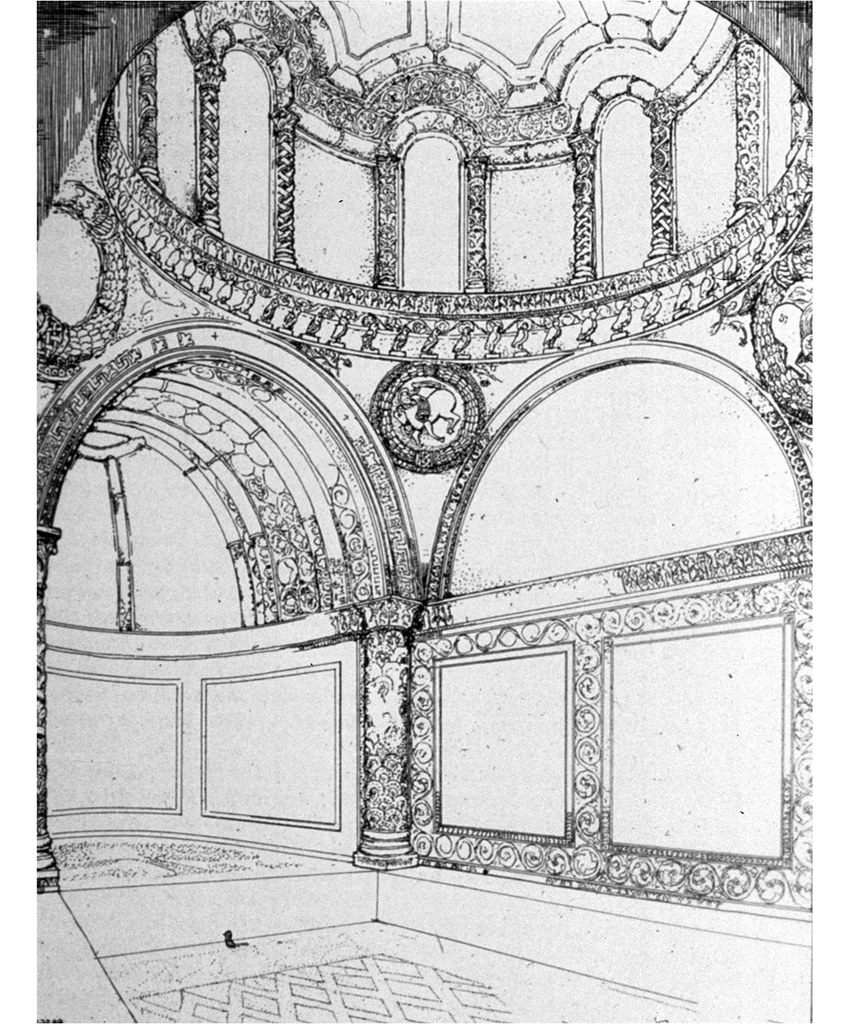
Such a depiction is, of course, permissible in the context of a fictional book illustrated by a fanciful artist. Its imaginative qualities contrast with the cautious work of art historians and archaeologists of the early Islamic period, who stick to documentable facts and fix their attention on masonry patterns and decor surviving in situ. One might even say that Fiala’s fictive reconstructions provide more realistic renderings than those presented in scholarly studies: an often reproduced depiction of the interior of Khirbat al-Mafjar, an Umayyad palace near Jericho, for example, details its stucco decoration and floor mosaics but leaves the space entirely devoid of furnishings or people (fig. 2). In her foundational article “The Draped Universe of Islam,” Lisa Golombek laments the “bare, cold stone walls and … nondescript quarters” of Khirbat al-Mafjar as portrayed in academic studies on the monument.L. Golombek, “The Draped Universe of Islam,” in Content and Context of Visual Arts in the Islamic World: Papers from a Colloquium in Memory of Richard Ettinghausen, Institute of Fine Arts, New York University, 2–4 April 1980, ed. P. Soucek (University Park, PA, 1988), 25–26. Khirbat al-Mafjar, sometimes called Qaṣr Hishām for its presumed founder, is published in R. W. Hamilton, Khirbat al Mafjar: An Arabian Mansion in the Jordan Valley (Oxford, 1959). Current excavations are supported by Birzeit University and University College London. The most recent report is by M. K. Hawari, “Landscape Archaeological Survey at Khirbat al-Mafjar—2009 and 2010,” Bulletin of the Council for British Research in the Levant 5 (2010): 21–34. More information at https://oi.uchicago.edu/support/jericho-mafjar-project-west-bank. Her essay argues that Islamic art historians ought to give more consideration to the substantial, even “exaggerated” role of textiles in Islamic society by considering textual and visual sources that attest to their ubiquity in the medieval world. “When we study Islamic architecture,” Golombek notes, “we tend to forget that doorways were hung with curtains; that hangings made the open colonnade a private place; that the bare floors, sometimes unpaved, were laid with carpets and mats; and that through these halls marched a continual procession of richly clothed personages.”Golombek, “Draped Universe,” 25–26.
Golombek’s description of Khirbat al-Mafjar pits the ghostly state of the ruins today against the once-lively appearance of the palace. In this essay, I aim to follow Golombek’s and Fiala’s leads to imagine the atmosphere of early Islamic living spaces by focusing specifically on furnishing textiles. The first section outlines difficulties in studying early Islamic textiles, while the second considers a corpus of fabrics that can be attributed to the era on stylistic, epigraphic, and technical grounds. Larger questions about the spread of designs and motifs in the early Islamic period are considered in the final section. The overall aim is to draw attention to an understudied group of early Islamic textile fragments and to reintegrate textiles into discussions of the built spaces of the Umayyad and early ʿAbbāsid worlds.For a broader discussion about the importance of considering textiles in architecture, see T. Weddigen, “Notes from the Field: Materiality,” ArtB 95, no. 1 (2013): 34–37. I thank Lauren Jacobi for this reference.
Problems of Defining and Dating Early Islamic Textiles
While it is easy to critique early Islamic architectural historians and archaeologists for omitting textiles in their evaluations of interior space, the reasons for this neglect are understandable: early Islamic textiles themselves are poorly preserved and only infrequently studied. There are few comprehensive studies of early Islamic textiles, many of which are fragments showing strong technical and visual continuities with earlier fabrics; these factors make it difficult to attribute or date them precisely to the period.L. W. Mackie, Symbols of Power: Luxury Textiles from Islamic Lands, 7th–21st Century (Cleveland, 2015), esp. 42–81, provides the most comprehensive overview of this category of textiles, rightfully tying together technical, art historical, and textual perspectives on Umayyad, ʿAbbāsid, and Fāṭimid textiles. Instead, early textiles are overshadowed by more complete (and, therefore, visually attractive) dress and furnishing textiles from the Ottoman, Mughal, and Ṣafavid eras, which also benefit from more abundant textual documentation.The work on these topics is expansive, and most impressively displayed recently at the Metropolitan Museum of Art: A. Peck, ed., Interwoven Globe: The Worldwide Textile Trade, 1500–1800 (New York, 2013); exhibition and catalogue reviewed by P. Rocco for CAA.Reviews, November 14, 2014, dx.doi.org/10.3202/caa.reviews.2014.130. Scholarship by Yumiko Kamada on the reception of Persian and Indian textiles in Japan and by Amanda Phillips on the Ottoman textile trade exemplifies these recent trends.

Significant numbers of early Islamic-era textiles remain in museum collections awaiting further study. Major hindrances to research include their lack of accompanying archaeological data and their traditional categorization and attribution according to style. Often labeled “Coptic,” they have been generally placed outside the scope of Islamic art, even though this capacious category includes pieces made after the arrival of Islam in the region.This is not a problem exclusive to early Islamic textiles, but to many other areas of early Islamic material culture that have been poorly or incompletely identified. The Metropolitan Museum of Art includes “Coptic” textiles in its galleries on Umayyad and ʿAbbāsid art; similarly dated textiles appear also in the “Crypt” section of the Medieval Department alongside material culture from late antique Egypt. The limitations of these taxonomic structures come to the fore in the case of large-scale fabrics. A large hanging from Egypt at the Metropolitan Museum of Art was assigned as “Coptic, VII century” when it was acquired in 1929 (fig. 3).“List of Gifts and Bequests of Mr. and Mrs. Harkness,” BMMA, n.s., 10, no. 2 (1951): 81. Recent carbon-14 analyses have zeroed in on a date range of 640–660, during the region’s transition to Islamic rule.The results yielded a date of 640–660 with 95% probability. See J. Ball, “Hanging with Images of Abundance,” in Byzantium and Islam: Age of Transition, 7th–9th Century, ed. H. C. Evans and B. Ratliff (New York, 2012), 13–14. The hanging’s technical and iconographic features in turn compare closely to two related textile fragments, one at Dumbarton Oaks and the other at the Israel Museum. Although these two pieces had been attributed at various times between the eighth and tenth centuries on purely stylistic grounds, they can now be placed more precisely in the seventh to eighth centuries.For discussion, see J. L. Ball, “Rich Interiors: The Remnant of a Hanging from Late Antique Egypt in the Collection of Dumbarton Oaks” in this volume. The Israel Museum piece (925.70) is dated to the ninth to tenth centuries in A. Baginski and A. Tidhar, Textiles from Egypt: 4th–13th Centuries C.E. (Jerusalem, 1980), 128, color plate V. This case demonstrates the difficulties in establishing clear dating parameters for textiles and shows how scientific analyses can revise the attribution of entire groups of textiles previously dated through style or iconography.See, in this volume, K. Colburn, “Loops, Tabs, and Reinforced Edges: Evidence for Textiles as Architectural Elements.”
The importance of identifying textiles in this manner and then integrating them into early Islamic material and visual culture cannot be understated. In sheer numbers, textiles undoubtedly represent the largest single category of evidence surviving from this period, and as such offer unique views on the visual and material culture of early Islam. For example, textiles show remarkable continuities in production techniques and iconographic conventions during a period of widespread cultural change in the seventh and eighth centuries. Further, the prevalence of textiles in early Islamic visual culture is underlined in ʿAbbāsid-era aḥādīth (Traditions of the Prophet), which recount Muḥammad’s disdain for curtains with figural images on them.“ʿAisha’s curtain” appears several times in various traditions, with different reactions depending on the ḥadīth. In Ṣaḥīḥ al-Bukhārī 6109, bk. 78, no. 136, ʿAisha narrates: “The Prophet entered upon me while there was a curtain having pictures (of animals) in the house. His face got red with anger, and then he got hold of the curtain and tore it into pieces. The Prophet said, ‘Such people as paint these pictures will receive the severest punishment on the Day of Resurrection.’” Ṣaḥīḥ al-Bukhārī, trans. M. Muhsin Khan, http://sunnah.com/bukhari/78/136. However, elsewhere in the same ṣaḥīḥ (2479, bk. 46, no. 40), the curtain is torn apart and made into pillows: “Narrated al-Qasim: ʿAisha said that she hung a curtain decorated with pictures (of animals) on a cupboard. The Prophet tore that curtain and she turned it into two cushions which remained in the house for the Prophet to sit on.’” Ibid., http://sunnah.com/bukhari/46/40. Interestingly, consideration of early Islamic debates about the legitimacy of representing figures has until now focused on evidence provided by the more permanent medium of wall and floor mosaics, images accessible only to certain viewers and only at certain times.For example, see the discussion by F. B. Flood, “Christian Mosaics in Early Islamic Jordan and Palestine: A Case of Regional Iconoclasm,” in Evans and Ratliff, Byzantium and Islam, 117; see also no. 79. But textiles were an omnipresent component of people’s visual repertory, and certainly part of the period’s debate about the legitimacy of figuration. Textiles are therefore crucial for understanding the material and visual culture of the early Islamic period, and merit more attention in art historical evaluations.
Zooming In: The Dumbarton Oaks Fragment and Its “Family”
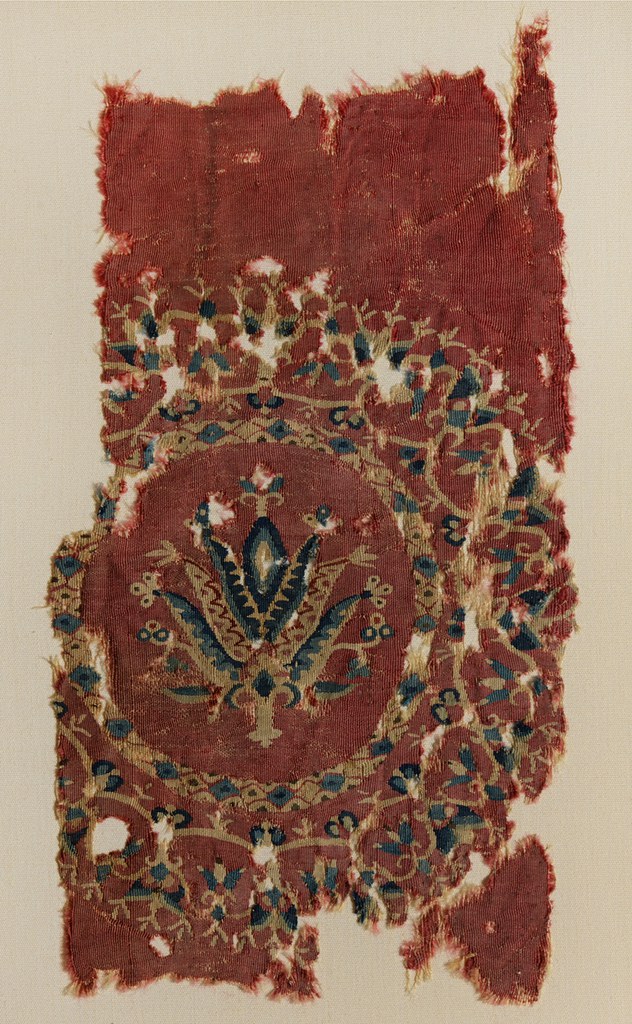
A group of textiles that can be dated to the early Islamic period on technical, stylistic, and scientific grounds provides an excellent case study for incorporating textiles into early Islamic interiors. A textile at Dumbarton Oaks serves as a starting point for this group (BZ.1945.1, fig. 4).D. Thompson, “Catalogue of Textiles in the Dumbarton Oaks Collection” (unpublished catalogue, Washington, DC, 1976), no. 60. The relatively small (29.4 × 16.8 cm) fragment is made of Z-spun, S-ply warp of undyed wool and Z-spun wefts of wool fibers dyed in a spectrum of colors. The composition is dominated by red, but also features at least three shades of blue in the design details. The high-quality weaving is characterized by tightly spun threads and dense weave structure. The textile depicts a circular motif resembling a lacelike wreath, with spindly tendrils encompassing a very finely rendered palmette. This design element is presented against a red background devoid of any figural or vegetal ornamentation. Dumbarton Oaks acquired the textile from the Brummer Gallery in New York in 1945. The dealer record card kept by the Brummer Gallery (now at the Metropolitan Museum of Art) notes that Joseph Brummer had acquired the textile in 1942 from Frank Tano, nephew of Phocion Tano, a Cypriot dealer based in Egypt.The piece (Brummer inv. N5323) is called a “very closely woven Coptic textile”: Thomas J. Watson Library, The Metropolitan Museum of Art, http://cdm16028.contentdm.oclc.org/cdm/compoundobject/collection/p16028coll9/id/18394/rec/10. The textile’s path through Tano’s galleries strongly supports the hypothesis that the piece was found in Egypt.

In her unpublished catalogue entry on this piece, Deborah Thompson placed the red Dumbarton Oaks fragment in the early Islamic period by comparing it to other related tapestry-woven fragments with similar design, iconography, coloration, and inscriptions. Scholars have argued that these fragments form a coherent group: Rodolphe Pfister, describing a fragment held at the Musée de Cluny in Paris, noted it was one of many pieces sharing an “aire de famille.”R. Pfister, “Matériaux pour servir au classement des textiles égyptiens postérieurs à la conquête arabe (suite),” Revue des arts asiatiques 10, no. 2 (1936): 73–85, esp. 82. Pfister dates the piece to the tenth–eleventh century. I have identified more than fifty related textiles that share stylistic, iconographic, and technical similarities: all are made of wool warp and weft and feature predominantly red backgrounds and ornamental patterns arranged in repeating medallions. The large size of some surviving fragments and the scale of individual motifs suggest the fragments were once furnishings, likely hangings, rather than elements of dress. For example, among several fragments of a once-integral fabric in the Benaki Museum there is at least one large element (51.5 × 49.0 cm) featuring a central field of wreathed medallions surrounding peacocks, interspersed with floral motifs; at right, the remains of a border featuring rows of braided, vegetal, and floral patterns have survived intact (fig. 5).M. Durand and F. Saragoza, eds., Égypte, la trame de l’Histoire: Textiles pharaoniques, coptes et islamiques (Paris, 2002), 173, no. 123. The entry lists several other related fragments from the Benaki Museum: 6978, 7061, 15146, 15423, 15456, 15618, 15622, 15625, 15631, and 15703.
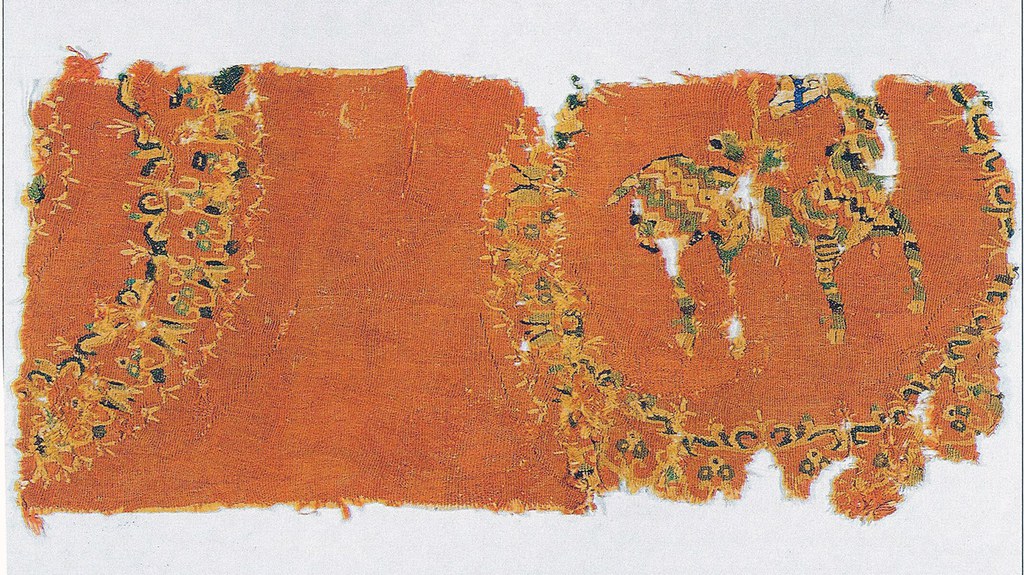

These fragments make it possible to imagine the original overall design of fabrics from this group, which likely all featured wreath-like medallions set on a red background and framed by elaborate border designs. A fragment in the Vatican Museum features two spindly wreath medallions set widely apart against a red background, much like the Dumbarton Oaks piece. The medallion on the right encloses a gazelle, deer, or riderless horse, with a quilt-like body of reds, tans, and blues (fig. 6).D. De Jonghe et al., Ancient Tapestries of the R. Pfister Collection in the Vatican Library (Vatican City, 1999), 136–37. Another fragment, from the Cleveland Museum of Art, includes an identical wreath medallion encompassing a gazelle or riderless horse (fig. 7).Cleveland Museum of Art, 1951.90, https://www.clevelandart.org/art/1951.90; Mackie, Symbols of Power, 56–57. Fragments at the Art Institute of Chicago (fig. 8) and the Musée de Cluny (fig. 9) preserve fragments of a border design that help us imagine the edges of our hypothetical textile.The fragment at the Art Institute of Chicago (1946.72) is unpublished. It measures 28 × 35 cm and, like other fragments of this group, features an undyed wool warp. I thank Daniel Walker for allowing me to study this piece. The piece at the Musée de Cluny (Cl. 21603) is published in A. Lorquin, Les tissus coptes au Musée national du Moyen Age, Thermes de Cluny: Catalogue des étoffes égyptiennes de lin et de laine de l’antiquité tardive aux premiers siècles de l’Islam (Paris, 1992), 311–13, no. 135. I thank Isabelle Bardiès-Fronty for allowing me to study this textile and its documentation. A piece in the Textile Museum (73.609) in Washington, DC, may also be related. The Cluny fragment still has two wreath medallions along one side; the remainder of the textile comprises several alternating red and blue rows of abstracted floral patterns, vegetal motifs, and gemstone-like circles on one side with a solid green row and solid yellow row.Similar yellow stripes serve as dividing frames in numerous tapestry-woven hangings; for example, along the bottom of the hanging with Hestia Polyolbos (BZ.1929.1) and around the frame of a hanging depicting hunters (BZ.1937.14). In fitting these pieces together, we can imagine that a complete textile featured an overall pattern of regularly spaced medallions filled variously with birds, quadrupeds, human figures, and vegetal motifs, all framed by a densely patterned border with rows of floral motifs.

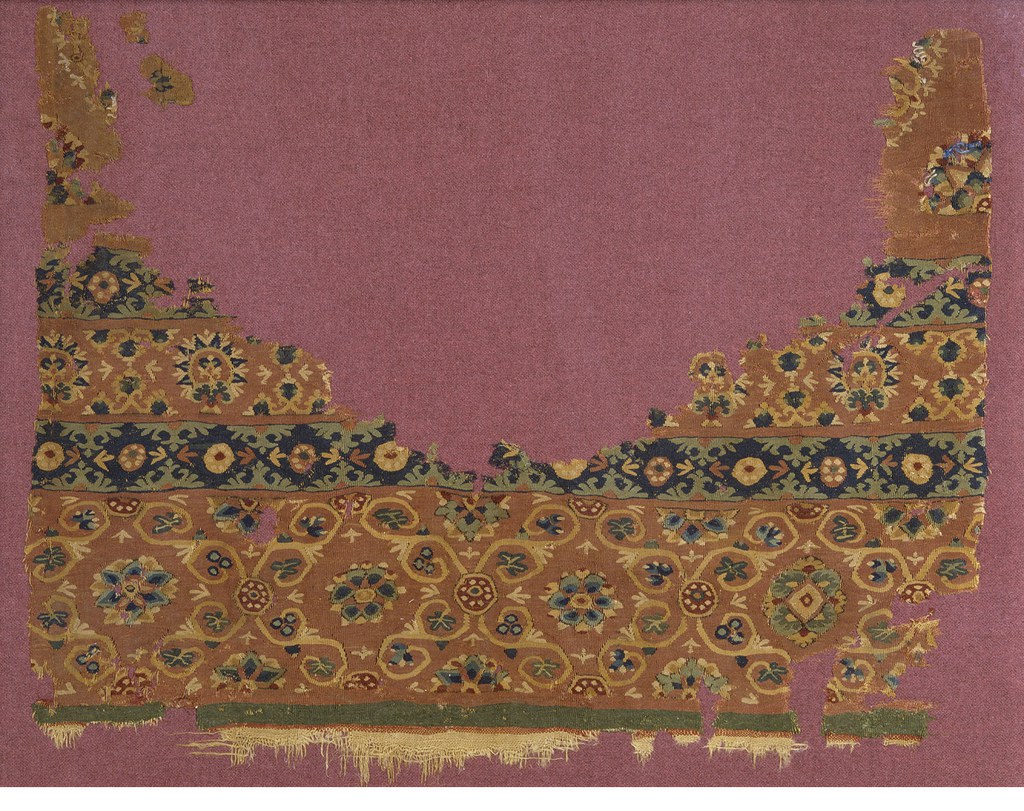
Although these textiles share many similarities, differences among the fragments are suggestive. First, quality varies significantly among these “family members.” Some, like the Dumbarton Oaks fabric, feature a dense weave structure and tightly woven threads with elegant designs and fine coloration. Others, like the fragment of a medallion surrounding a vegetal pattern now at the Textile Museum (73.578) in Washington, DC, are clumsily rendered, with loosely woven threads and asymmetrical designs, perhaps the product of a less sophisticated weaver.
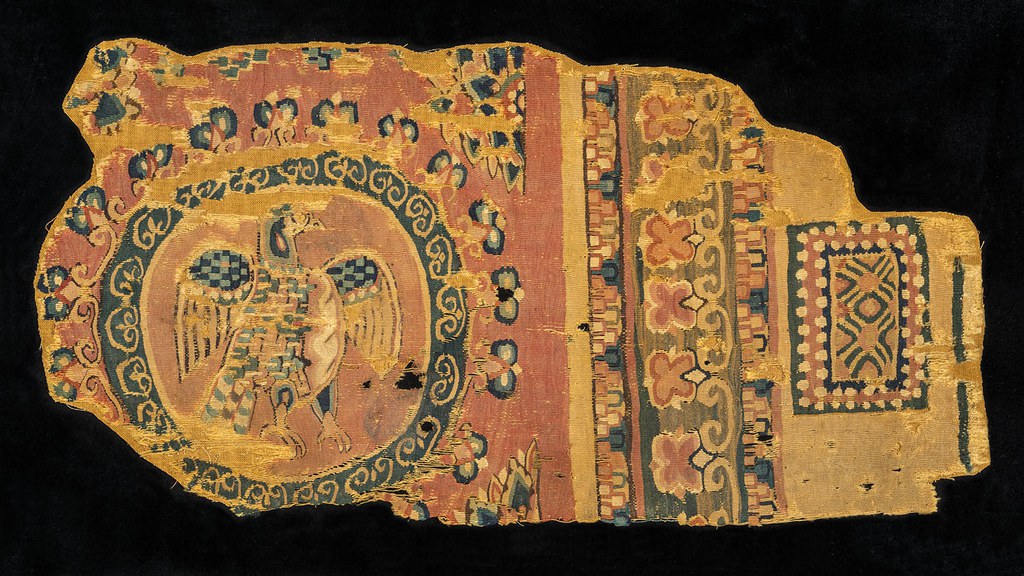
Second, the iconography and design details in the central fields and along the borders vary within the group. For example, a fragment at the Textile Museum (73.577) features an eagle set within a round frame, from which emerges a Sassanian-style winged motif.Both Textile Museum fragments (73.577 and 73.578) are unpublished and have not been photographed by the museum. I thank Sumru Krody for allowing me to study these textiles in person with her. Another piece with an eagle, at the Montreal Museum of Fine Arts, places the bird within a medallion pattern of a heavy, blocky style; the fabric’s colorful border includes an abstracted gemstone motif (fig. 10). A piece at the Metropolitan Museum of Art incorporates bands of yellow and green, hinting that some examples featured edges comprising variously colored bands (fig. 11).

Third, technical details of the textiles vary significantly. Most are made of Z-spun threads (with S-ply warps), a feature considered typical of production outside Egypt and usually associated with Mesopotamia. However, a few pieces feature S-spun threads, generally considered typical of Egyptian fabrics.The question of spin direction and its relationship to the geographical production center of a fabric is contested. The majority of textiles found in Egypt are S-spun, and so the appearance of a concentrated group of Z-spun fabrics may suggest production outside of Egypt. For a discussion of the various explanations for difference in spin directions in Europe, the Middle East, and Egypt, see E. J. W. Barber, Prehistoric Textiles: The Development of Cloth in the Neolithic and Bronze Ages with Special Reference to the Aegean (Princeton, NJ, 1991), 65–68. In their overall visual aesthetics, too, the textiles point outside the Mediterranean orbit: with their highly stylized bird and animal motifs, winged details, and ornate floral patterning, the red textiles draw from a Persianate artistic vocabulary.The classic text on the topic is R. Ettinghausen, From Byzantium to Sasanian Iran and the Islamic World: Three Modes of Artistic Influence (Leiden, 1972).
Lastly, the tightness of the threads and weave structures ranges substantially across the group, suggesting varied quality in production. The Dumbarton Oaks piece, for example, features a highly dense weave, with few slits between color fields; such weaving is possible only with careful effort and skill. Examples featuring S-spun threads tend to feature coarser weave structures and less finely rendered details.Because technical analyses are not consistently published and should be confirmed by personal study, these observations can only be based on individual catalogue entries. To take only the examples at the Textile Museum as a sample, the majority of the pieces there are Z-spun; however, four iconographically similar pieces in fact comprise S-spun threads (73.537, 73.600, 73.685, 73.690). Sumru Krody kindly provided access to these textiles and the technical analyses. For a selection of published thread analyses, see the Vatican pieces published in De Jonghe et al., R. Pfister Collection, inv. 6983 (ill. LXIVa–b), 6988 (ill. LXVa–c), 7440 (ill. LXVII), 7443 (ill. LXVII), and 7445 (ill. LXIX); numerous examples in Berlin analyzed and reproduced in K. Brisch, ed., Islamische Kunst: Loseblattkatalog unpublizierter Werke aus deutschen Museen, vol. 2, Metall, Stein, Stuck, Holz, Elfenbein, Stoffe (Mainz, 1984), 243–54; and the three pieces at the Musée de Cluny, inv. Cl. 22474 (Lorquin, Tissus coptes, 256–58), inv. Cl. 22043 (ibid., 258–59), and inv. Cl. 21603 (ibid., 331–33). Further scientific analyses of the threads, including the identification of the species of animal producing the wool and the chemical makeup of the dyes used, will certainly help in identifying subsets of textiles and possibly point more conclusively to places of production.
Inscribed Furnishing Fabrics
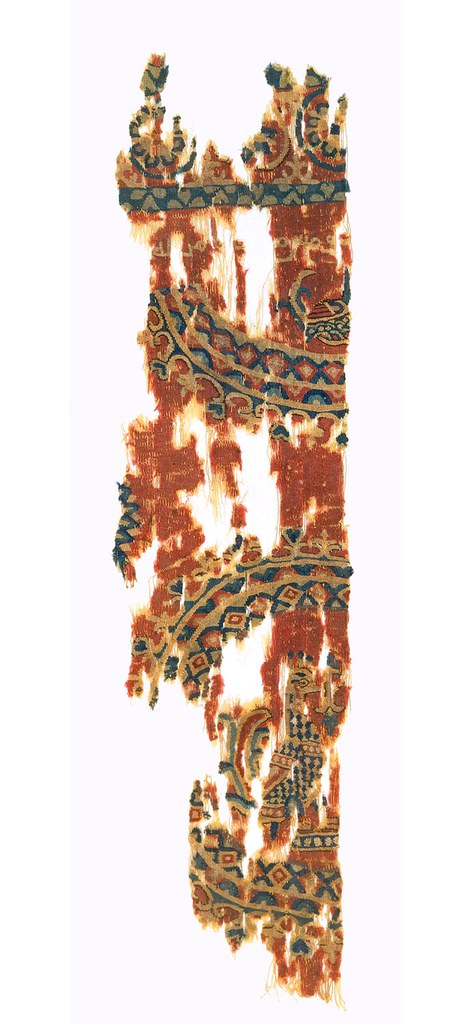
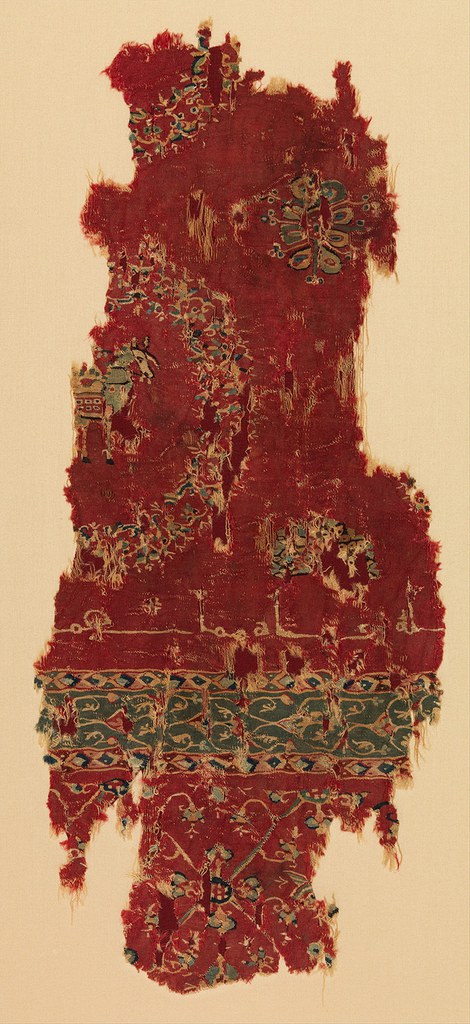
Dating textiles acquired on the art market is often exceedingly difficult, but the red group includes a number of examples featuring Arabic inscriptions in Kufic style, a calligraphic convention associated with the Umayyad (661–750 CE) and early ʿAbbāsid (750–ca. 850 CE) dynasties. These inscriptions, along with the carbon-14 dating results, place the group of textiles in the early Islamic period.In addition to the three textiles that follow in the text, three other similar pieces have Arabic inscriptions. A fragment at the Textile Museum (73.685) preserves a fragmentary Kufic inscription, about which I have not found any note and which remains undeciphered. Thompson, “Catalogue,” cat. no. 160, n1, notes that at least one piece in Cairo featured an inscription, and provides the accession number 15480; Iman Abdulfattah kindly checked her records of textiles from Cairo for this piece to no avail, and so the object remains unidentified. In their entry on Textile Museum, 73.524, Ernst Kühnel and Louisa Bellinger note that the Cairo fabric “shows the remains of a kufi text, too incomplete to allow a correct interpretation”: E. Kühnel and L. Bellinger, Catalogue of Dated Tiraz Fabrics: Umayyad, Abbasid, Fatimid (Washington, DC, 1952), 5–6. Lastly, a fragment of a band at the Cleveland Museum of Art, 1982.297, measuring 15.7 × 25.2 cm, features a fragmentary inscription in a floral Kufic style: http://www.clevelandart.org/art/1982.297. The first piece, in the Textile Museum, includes an inscription which Ernst Kühnel reads as “The Commander of the Faithful, Marwan. This has been ordered . . .” (fig. 12). He thus dates the piece to the reign of the Umayyad caliph Marwān I (684–685 CE) or, more likely, Marwān II (744–749 CE).Kühnel and Bellinger, Catalogue of Dated Tiraz Fabrics, 5–6. This piece and the “Marwān” ṭirāz are in fact the oldest securely dated Islamic textiles. The Arabic inscription reads (“Amīr al-Mu’minīn M[arwān] . . . Amīr ba . . .”). Bellinger and Kühnel argue that Marwān brought the textile with him to Egypt, and that it remained in the Fayyūm (a city in Egypt) following his death there. Its Z-spun structure places it in the category of pieces associated with Mesopotamia. A second fragment, at the Metropolitan Museum of Art, from a different piece of cloth, includes a woven inscription reading “of what was made,” likely followed by generic blessings (fig. 13).The inscription likely reads “mimmā ʿumila.” I thank Matthew Saba, Metropolitan Museum of Art, who kindly shared his interpretation. Museum records indicate that it has been radiocarbon-dated with 95% confidence to 663–868, placing it squarely in the late Umayyad or early ʿAbbāsid period.This information is recorded in the Metropolitan Museum of Art’s object file. Kathrin Colburn kindly studied this textile with me. Another radiocarbon-dated fragment in the Katoen Natie collection, similarly in Z-spun technique with wool warp and weft, was dated to 690–750 with 95.4% confidence.Antwerp, Katoen Natie, KIA-17641: A. De Moor, M. van Strydonck, and C. Verhecken-Lammens, “Radiocarbon Dating of Two Sasanian Coats and Three Post-Sasanian Tapestries,” in Riding Costume in Egypt: Origin and Appearance, ed. C. Fluck and G. Vogelsang-Eastwood (Leiden, 2004), 181–88, results on 185, color fig. 32.

Lastly, an inscribed piece in the Cleveland Museum of Art survives nearly complete (fig. 14).This piece measures 80.0 × 83.2 cm. D. G. Shepherd, “An Early Ṭirāz from Egypt,” The Bulletin of the Cleveland Museum of Art 47, no. 1 (1960): 7–14; Cleveland Museum of Art, 1959.48, http://www.clevelandart.org/art/1959.48. The textile is identified as a furnishing textile in A. Paetz gen. Schieck, “Late Roman Cushions and the Principles of Their Decoration,” in Clothing the House: Furnishing Textiles of the 1st Millennium AD from Egypt and Neighbouring Countries, ed. A. De Moor and C. Fluck (Tielt, 2009), 131. While it shares many similarities with the other pieces discussed here, its differences are more significant: the textile’s design is dominated by medallion frames composed of pearls rather than floral patterns; it includes both green and red backgrounds; and its warp is recorded as linen, rather than wool, a weaving material more common in textiles made in Egypt. The fabric is dated to the early ʿAbbāsid period through its Kufic calligraphy, and has been assigned to a workshop (ṭirāz) in Bahnasā, Egypt, known for producing furnishing textiles with inscriptions.R. B. Serjeant, “Material for a History of Islamic Textiles up to the Mongol Conquest,” Ars Islamica 13 (1948): 75–117, esp. 107–8 for discussion of Bahnasā in Arabic textual sources. The piece’s inscription does not name the caliph, but rather provides generic blessings: “In the name of Allah. Blessing from Allah to its owner. Of what was made in the tiraz.” The fabric’s S-spun threads support attribution to an Egyptian workshop.Mackie, Symbols of Power, 56–57, and Paetz gen. Schieck, “Late Roman Cushions,” 131n48.
These considerations of the Dumbarton Oaks fragment and related fabrics lead to a few general observations about the group. First, the fragments’ dating falls generally in the late seventh- to early ninth-century range based on stylistic, epigraphic, and scientific considerations. Second, although they were all found in Egypt, the technical features of most of the fragments—wool warps and wefts, along with the Z-spun threads—point to production in Mesopotamia. Third, the S-spun examples are on the whole less finely woven and designed than those with Z-spun threads, suggesting that they were imitations made in Egypt. Fourth, the red textiles bear visual similarities to early Islamic silks generally and Sassanian textiles specifically, including their color choice, motifs, and ornamentation, suggesting a visual aesthetic drawn from the eastern Islamic world. Lastly, and importantly, the size of the large pieces and the proportions of the design elements of fragments point to their use as furnishings. Indeed, none identified so far demonstrate any seaming or tailoring associated with fabrics purposed for clothing.
Documenting Early Islamic Interiors
Considering the technical features of this group of textiles leads to important observations about manufacture, iconography, and design. Moreover, understanding the textiles’ functions as furnishings requires a broader view, taking into account textual, architectural, and archaeological evidence in tandem with that offered by close examination of the weavings. Textual sources provide a means of imagining the uses, meanings, and associations of these fragments in Umayyad and early ʿAbbāsid contexts as part of palatial or domestic decor. ʿAbbāsid-era sources are particularly rich in providing a sense of the luxurious decorations favored by the court and elite owners. For example, the Book of the Monasteries (Kitāb al-Diyārāt) by al-Shābushtī notes that the palaces of the ʿAbbāsid caliphs at Sāmarrāʾ featured extensive floor coverings, making it possible to imagine the luxurious furnishing textiles that once adorned imperial residences.Abū l-Ḥasan ʿAlī ibn Muḥammad al-Shābushtī, The Shabushti’s Book of Monasteries: Al-Diyarat, ed. G. Awwad (Piscataway, NJ, 2008), 364–71. The ninth-century Brocaded Book (Kitāb al-Muwashshā) by al-Washshāʾ details at great length the interiors of the well-to-do citizens of Baghdad, including particular descriptions of the curtains and pillows of the capital city’s urbane homes, many of which are noted as having extensive poetic inscriptions woven on them.Muḥammad ibn Isḥāq ibn Yaḥyā al-Washshāʾ, Le Livre de Brocart (al-Kitāb al-Muwashshā), ed. and trans. S. Bouhlal (Paris, 2004); idem, Kitāb al-Muwashshā, ed. R. E. Brünnow (Leiden, 1886). Fāṭimid sources, though slightly later in date, provide excellent information attesting to textile uses in Egypt, especially in domestic contexts. Among the texts found in the Cairo Geniza are contracts relating women’s possessions upon marriage. These include extensive, detailed lists of the pillows, curtains, cushions, floor coverings, and hangings belonging to brides, which are listed according to the textile type and their monetary values.S. D. Goitein, A Mediterranean Society: The Jewish Communities of the Arab World as Portrayed in the Documents of the Cairo Geniza (Berkeley, CA, 1967–93): 4:310–44.
While none of the textual accounts is specific enough to be matched to the fabrics described here, the sources immerse the modern reader in the lushly curtained and cushioned environments of early Islamic palaces and domestic settings. These sources make clear that the textiles were often the most valuable items on display in an interior. Because texts go to great lengths to describe the appearances of early Islamic homes, we can guess that visitors understood that the quality and variety of interior furnishings reflected the social standing of their owners. That furnishing textiles are often described alongside jewelry and clothing makes clear that these fabrics were understood to operate in a manner similar to dress, at once constructing and conveying the identity of the individual and the household to which they belonged.For the alignment of individual identity and household decor, see T. K. Thomas, “Material Meaning in Late Antiquity,” in Designing Identity: The Power of Textiles in Late Antiquity, ed. T. K. Thomas (Princeton, NJ, 2016), 20–53; eadem, “The Honorific Mantle as Furnishing for the Household Memory Theater in Late Antiquity: A Case Study from the Monastery of Apa Apollo at Bawit,” in this volume.

In the case of this group of related red textiles, for example, the variety in quality and technical features points to widespread taste for the type, possibly among a range of consumers or over a period of time. One possibility is that red woolen fabrics presented an affordable alternative to high-status, red-hued silks like the “Marwān” ṭirāz, which also features a red background, Arabic inscription, and medallion patterning (fig. 15).London, Victoria and Albert Museum, 1314-1888 and T.13-1960. A summary of recent literature is found in Evans and Ratliff, Byzantium and Islam, no. 173-A. See also, in this volume, A. Shalem, “‘The Nation Has Put On Garments of Blood’: An Early Islamic Red Silken Tapestry in Split.” Such early Islamic silks survive in small enough numbers to suggest they were especially rare even in their time, and one assumes they were intended only for the uppermost social stratum; the humbler fragments may indeed have responded to specific demands for imitations of these elite furnishings among a wider social set. Indeed, imitation is built into the very structure of the woolen fabrics: whereas silk patterns repeat ad infinitum thanks to the mechanized nature of their looms, the designs of the tapestry-woven fabrics are created by hand. This means that a tapestry weaver must show great mastery and control of technique, since he or she cannot rely on any mechanical process inherent to the drawloom itself to create repeating and symmetrical patterns.This aesthetic of repetition and mirroring is discussed by J. Trilling, The Medallion Style: A Study in the Origins of Byzantine Taste (New York, 1985). One wonders if this artistic bravura was recognized at the time, and if it was part of the appeal.
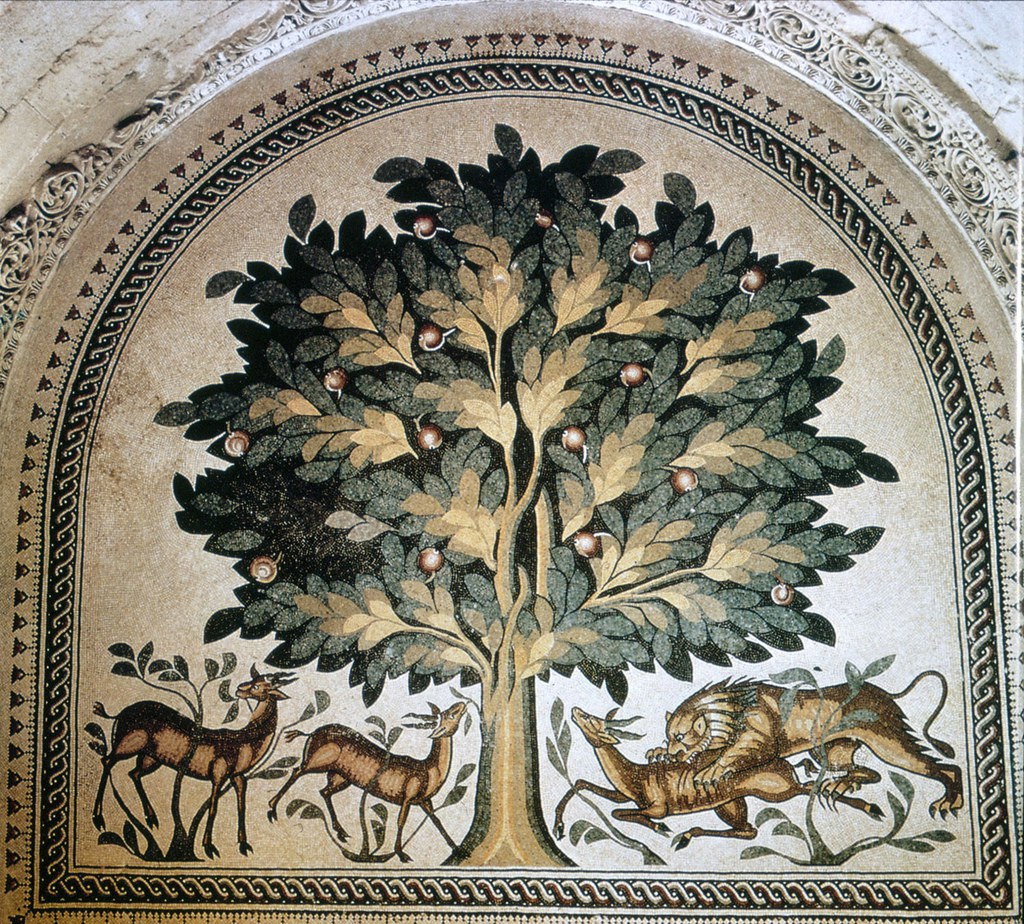
Second, early Islamic architectural and archaeological evidence offers a potential wealth of information for situating furnishing textiles in the architecture of the time. Unfortunately, Umayyad and early ʿAbbāsid structures have not yet been mined for hooks, rods, and other technical details that would point more definitively to the locations of furnishing textiles in the built environment. For now, we might rely on other kinds of surviving architectural evidence to envision the uses of textiles in early Islamic spaces. For example, the floor mosaics of the bathhouse at Khirbat al-Mafjar provide an interesting case for using surviving in situ evidence as a way of understanding the ephemeral use of textiles. The heraldic floor mosaic of the so-called dīwān, or reception room, for example, features small tassels emulating the fringe of a textile (fig. 16). These imitative tassels raise the possibility that mosaicists modeled their compositions on actual existing textiles. Equally intriguing is the distinctive running strip of repeating pattern mosaics leading from the exterior door of the bathhouse to this special audience room (figs. 17–18). Ellen Swift has argued that in the Roman world, patterned strips like these were used in transitional spaces like hallways to direct visitors along prescribed paths.E. Swift, Style and Function in Roman Decoration: Living with Objects and Interiors (Farnham, UK, 2009). In the case of Khirbat al-Mafjar, one wonders whether the mosaics marked a ceremonial route for the caliph or his visitors into the bathhouse and onward to the reception room, and whether these pathways were cloaked in furnishing fabrics. Close scrutiny of surviving archaeological remains will be necessary to shed more light on the role of textiles in shaping the divisions and functions of space in these palace structures.Hana Taragan considered the influence of textiles on the decoration at Khirbat al-Mafjar in a presentation, “Beyond the Veiled Wall: Textile Obsession in the Umayyad Palace at Khirbat al-Mafjar,” part of the panel “Draping the Middle Ages,” organized by Patricia Blessing at the College Art Association conference, Washington, DC, February 4, 2016.


A Taste for Textiles
Situating the “red family” textiles in the context of the early Islamic built environment raises questions about period tastes in interior decoration more generally. On the most basic level, imagining textiles in situ provokes questions about the ornamental and decorative exchanges between fabric and architectural decoration, a topic that arguably remains the most important legacy of Golombek’s essay.Golombek, “Draped Universe,” 34, makes the association between textiles and wall-surface decor: “If one studies the evolution of surface decoration, it becomes increasingly clear that the practice of hanging the walls with textiles led to the development of mosaic faience and polychrome painted panels. The walls were broken up into small rectangular panels, as if they were products of the loom. The pattern changes abruptly from one panel to the next, as if the eye were moving from fabric to fabric. . . . [Such] cases show the imprint of the technique of weaving itself. . . . This woven decoration allowed the architect to virtually swathe his forms and thereby bring out the volumetric quality of the architecture, as if it were, in fact, draped with textiles.” Václav Fiala, in fact, fancifully imagined exactly such a visual effect of textiles in an illustration in Pán Amry, in which textiles provide the backdrop of a scene where the characters Basil and Jurata encounter the Umayyad caliph Hishām (fig. 19).Musil, Pán Amry, 64. By layering textiles into early Islamic architectural decoration, it is possible to deepen our appreciation of early Islamic aesthetics, particularly in terms of color and motifs. For example, recent work on Sāmarrāʾ has considered the architecture’s colorful decoration, which included painted stucco, inlaid glass, mosaics, and other decorative elements.M. D. Saba, “Abbasid Lusterware and the Aesthetics of ʿAjab,” Muqarnas 29 (2012): 187–212; Saba also organized an recent exhibition at the Metropolitan Museum of Art on the topic of visual effects of interiors, Pattern, Color, Light: Architectural Ornament in the Near East (500–1000) (July 20, 2015–January 10, 2016), with a full object list available on the Metropolitan Museum of Art’s website, www.metmuseum.org/exhibitions/listings/2015/pattern-color-light. The exhibition was reviewed by K. Malas, JSAH 75, no. 2 (2016): 238–39. See also M. Milwright, “Fixtures and Fittings: The Role of Decoration in Abbasid Palace Design,” in A Medieval Islamic City Reconsidered: An Interdisciplinary Approach to Samarra, ed. C. F. Robinson (Oxford, 2001), 79–109, especially 105–8 for discussion of furnishings in Sāmarrāʾ. The coloristic effects of this decoration would have been amplified when the space was enhanced with silks or tapestry-woven furnishing fabrics, which employ a rich range of blues, greens, yellows, and reds to similarly kaleidoscopic visual effect. In fact, the site’s architectural decoration indicates a close visual connection between permanent structures and ephemeral textiles: for example, fragments of paintings from Dār al-Khilāfa, a palace complex built by the caliph al-Muʿtaṣim around 836 CE, depict a running frieze of forward- and reverse-facing birds set in consecutive pearl medallions, reminiscent of the iconography and design of early Islamic silks and the red woolen textiles discussed above (fig. 20).E. Herzfeld, Die Malereien von Samarra (Berlin, 1927). Painting fragments and the original watercolor reproductions are kept in the Museum für Islamische Kunst in Berlin. For a recent discussion of the paintings and critique of earlier interpretations, see E. Hoffman, “Between East and West: The Wall Paintings of Samarra and the Construction of Abbasid Princely Culture,” Muqarnas 25 (2008): 107–132.
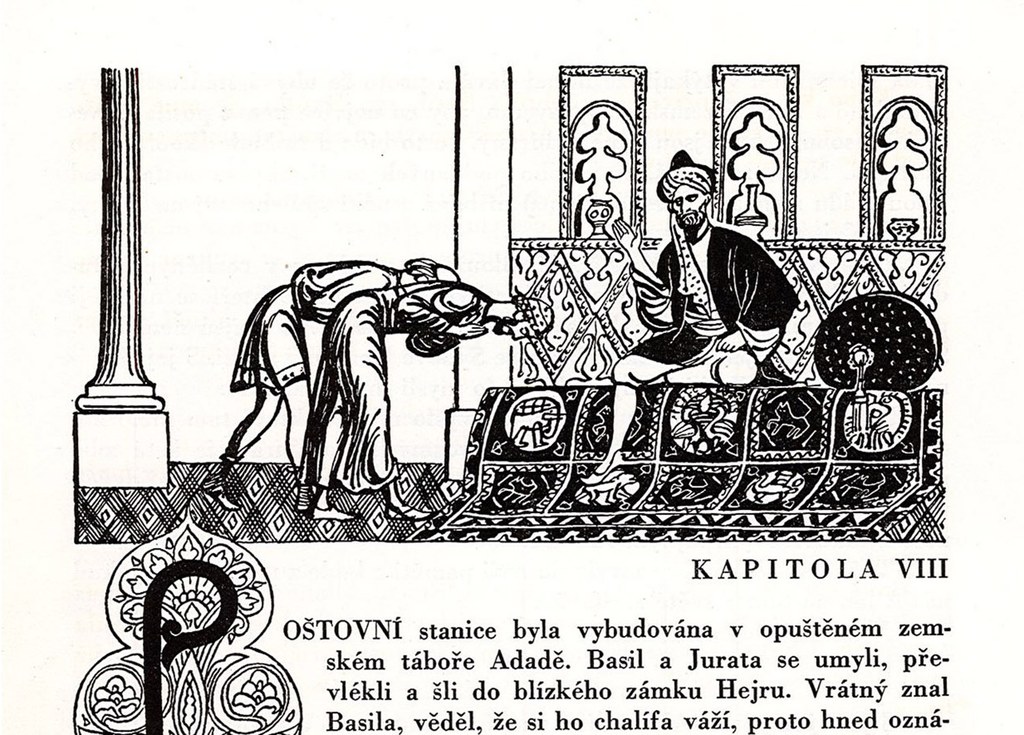

Beyond aesthetic concerns, we should also understand furnishing textiles like the red fabrics in terms of their functions, particularly how they could be deployed to demarcate and control access to privileged areas.J. W. Stephenson, “Veiling the Late Roman House,” Textile History 45, no. 1 (2014): 3–31; A. Shalem, “Manipulations of Seeing and Visual Strategies in the Audience Halls of the Early Islamic Period,” in Visualisierungen von Herrschaft: Frühmittelalterliche Residenzen; Gestalt und Zeremoniell, ed. F. A. Bauer (Istanbul, 2006): 213–32. This was certainly the case in early ʿAbbāsid court ceremonial, which, like Byzantine practice, involved complex rituals of hiding and revealing the ruler and the court, presumably to heighten viewers’ expectations and to use space to suggest hierarchies of power.M. Canard, “Le cérémonial fatimite et le cérémonial byzantin: Essai de comparaison,” Byzantion 21, no. 2 (1951): 355–420. In his work on palace decoration at Sāmarrāʾ, Matthew Saba has argued that the site’s ambient decor was marshaled to control visual access to the caliph; textiles, certainly silks and carpets, were essential to the orchestrated veiling and unveiling of the ruler, and worked in tandem with the architectural frames in which they were set.M. D. Saba, “A Restricted Gaze: The Ornament of the Main Caliphal Palace of Samarra,” Muqarnas 32 (2015): 155–95. The survival of so many fragments of red-hued hangings of such varying quality suggests that they were made for a wide social spectrum, and that similar practices may have taken place in a corresponding range of interiors.
In the broader sense, however, placing the red fabrics as part of early Islamic interior decor also raises methodological questions about how best to understand the spread of interior design from one region to another. The red textiles may have been brought to Egypt from Mesopotamia because they were in vogue or were valued for their associations with their distant places of production. The transregional spread of interior decoration is rarely described in premodern contexts, though it is well documented in nineteenth- and twentieth-century international design phenomena like Art Nouveau or Bauhaus.The limits of current theoretical approaches to interiors are discussed in A. G. Winton, “Inhabited Space: Critical Theories and the Domestic Interior,” in The Handbook of Interior Architecture and Design, ed. L. Weinthal and G. Brooker (London, 2013), 40–49. For a useful anthology on interior design theory, see M. Taylor and J. Preston, eds., Intimus: Interior Design Theory Reader (Chichester, 2006). With these parallels in mind, we might then understand the red textiles as popular interior furnishings of the early Islamic era, presumably imported from abroad and eventually copied locally by Egyptian elites wishing to emulate the interior furnishings of their counterparts in Mesopotamia. A parallel transfer of architectural decoration from Mesopotamia to other regions can be seen in the spread of Sāmarran stucco designs simultaneously in several regions in the ninth and tenth centuries. The appearance of specific designs in sites stretching from central Asia to Egypt has been usually attributed to the centripetal pull of Baghdad in provincial outposts, to the desire of local patrons to align themselves with the Mesopotamian heartlands, and to the movement of early ʿAbbāsid craftsmen; aesthetic and practical concerns, such as a desire for repetition and the ease of repeating the pattern, have also been proposed to explain the enduring popularity of Sāmarran styles well into the medieval period.K. A. C. Creswell, Early Muslim Architecture: Umayyads, Early ʻAbbāsids and Ṭūlūnids, 2 vols. (Oxford, 1932–40), 2:355–56; R. Ettinghausen, “The ‘Beveled Style’ in the Post-Samarra Period,” in Archaeologica orientalia in memoriam Ernst Herzfeld, ed. G. C. Miles (Locust Valley, NY, 1952), 72–83; M. Meinecke, “Early Abbasid Stucco in Bilād al-Shām,” in Bilād al-Shām during the Abbasid Period (132 A.H./750 A.D.–451 A.H./1059 A.D.), ed. M. ‘A. Bakhit and R. Schick (Amman, 1991), 226–67. See also the recent discussion in F. B. Flood, “Faith, Religion, and the Material Culture of Early Islam,” in Evans and Ratliff, Byzantium and Islam, 244–57, esp. 256–57. These appear, for example, in Egypt in the Mosque of Ibn Ṭūlūn (ca. 879 CE), in the Monastery of the Syrians in Wādi al-Naṭrūn (ninth or early tenth century CE), and in the Masjid-i No Gunbad in Balkh, Afghanistan (ninth century CE).M. Immerzeel, “Playing with Light and Shadow: The Stuccoes of Deir al-Surian and Their Historical Context,” Eastern Christian Art 5 (2008): 59–74; L. Golombek, “Abbasid Mosque at Balkh,” Oriental Art 15, no. 3 (1969): 173–89. Sāmarrāʾ-style decoration was also found in the reception rooms of a private home in Fusṭāṭ, Egypt, in a context K. A. C. Creswell dated to around 900 CE based on historical conditions of the neighborhood’s founding and destruction (figs. 21–22).Creswell, Early Muslim Architecture, 2:365–66.
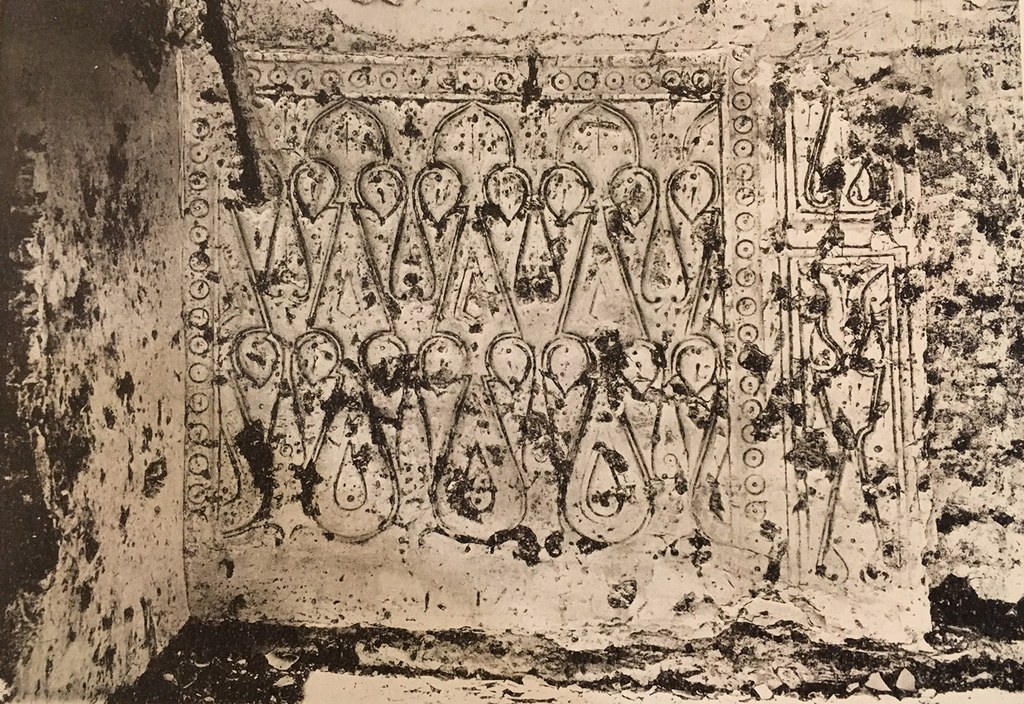
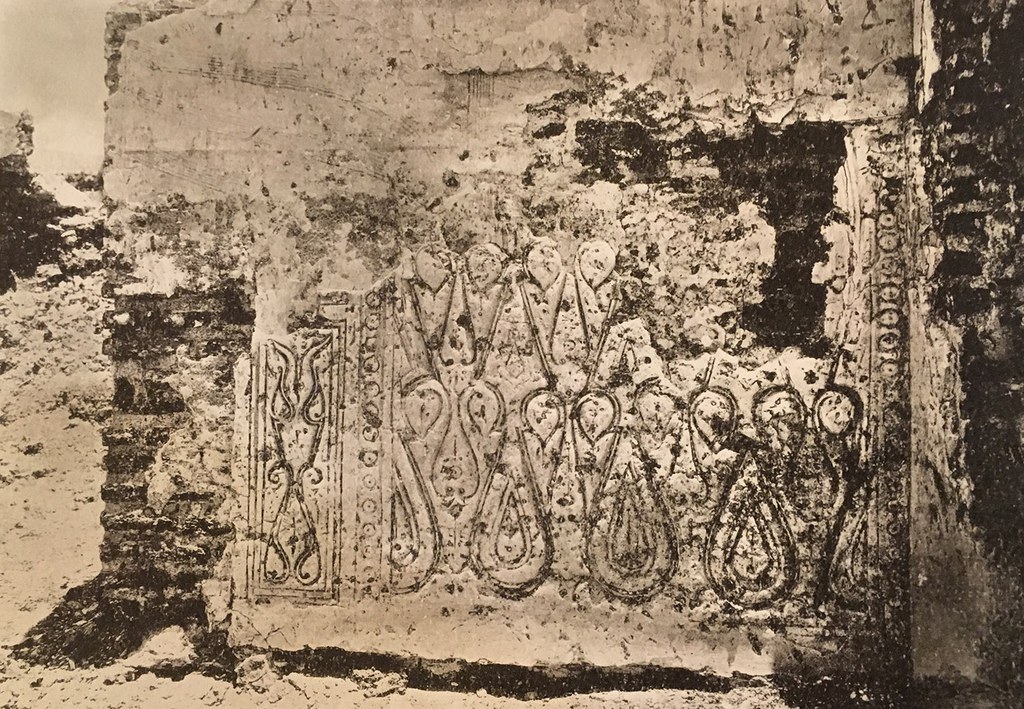
The wide-ranging appearance of stucco decor in major city mosques, monastic chapels, small local prayer halls, and private residences—along with the sheer numbers of red textiles of varied quality—attests to popular preferences for a particular decorative aesthetic across a broad social spectrum in early Islamic Egypt. The relatively tight time frame of the monuments and textiles points to a particular vogue for styles of interior decoration, linked to changing tastes or particular circumstances of the time, that looked eastward toward the Persianate-infused styles developed in central ʿAbbāsid lands. The archaeological and material evidence presented in this essay suggests that period tastes for interior decoration had little to do with the functions of the buildings or the religious identities of their inhabitants. These observations thus disrupt any notion of premodern architectural decor as ingrained, culturally determined, or strictly utilitarian; instead, we begin to understand that the denizens of the early Islamic Mediterranean decorated their homes according to changing desires, as they seem to have embraced an international style associated with the Mesopotamian heartlands. In this sense, the spread of interior furnishings parallels that of dress of the same period, which also followed changing tastes and drew increasingly on Persianate styles.For discussion of the pan-Mediterranean spread of fashion styles, see J. L. Ball, Byzantine Dress: Representations of Secular Dress in Eighth- to Twelfth-Century Painting (New York, 2005) and Y. Stillman, Arab Dress: A Short History; From the Dawn of Islam to Modern Times (Leiden, 2000). We might conclude that the people of ninth-century Egypt who adorned their abodes with bright red textiles picked their furnishings as they would their clothing: attuned to region-wide trends in interior decor and keenly aware of the power of furnishings to convey information about owners’ social standing and sensibilities.
Conclusion
Considering the red woolen textiles alongside textual, architectural, and archaeological evidence raises questions about consumption, display, and tastemaking in the early Islamic world. At the same time, connecting these strands of evidence requires some leaps of imagination: no complete red woolen hanging survives intact, and no textiles have been preserved in situ to prove how they were used in architectural settings. And yet, visualizing textiles in now-empty archaeological structures presents us with a far richer picture of early Islamic material and visual culture, an imaginative vision closer perhaps to Fiala’s depictions of Quṣayr ʿAmra that opened this essay. Our minds can fill today’s cold floors and bland walls with the brightly hued fabrics that warmed rooms, softened sound, and added color to the homes and palaces of the Umayyad and early ʿAbbāsid worlds.
In preparing this article for print, I am exceedingly grateful for the efforts of the Publication Department at Dumbarton Oaks, especially Joel Kalvesmaki, Kathy Sparkes, and Lain Wilson; Shannon Wearing’s copyedits only improved the text. I wish also to thank those who assisted me in securing image rights, in particular Radka Fialová, Sumru Krody, Mina Moraitou, James Moske, Matthew Saba, Marie-Claude Saia, Hamdan Taha, and Donald Whitcomb. Lastly, I express deepest gratitude to the other contributors in this volume for enthusiastically supporting our project on furnishing textiles.
Cite this Essay
Elizabeth Dospěl Williams, “A Taste for Textiles: Designing Umayyad and ʿAbbāsid Interiors,” in Catalogue of the Textiles in the Dumbarton Oaks Byzantine Collection, ed. Gudrun Bühl and Elizabeth Dospěl Williams (Washington, DC, 2019), https://www.doaks.org/resources/textiles/essays/williams.
